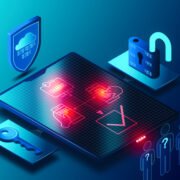95% of all cyber security breaches occur due to human error, which is avoidable.
Companies hit a pause and spend precious time and money resolving data breaches. Also, you could be on the hook for legal fees depending on the data compromised. Victims could also request compensation resulting in revenue loss for your organization.
Don’t assume that your small business is safe; these enterprises are the worst hit. But, identifying and avoiding IT security mistakes will protect your company from cybercriminals. You’ll also be better prepared in case of a security threat.
You’ll keep your business safe if you can avoid these security mistakes.
Lack of Spyware Scanners and Antivirus Software
Computers aren’t designed to be connected to the Internet without defensive software. Firms without protective software risk picking up viruses or being targeted by malware that can remain undetected.
Antivirus software operates by checking your files and programs against a database of malware. Since hackers are developing new viruses, antivirus software scans your system for new threats. When it finds a virus in a file, the software quarantines it, marks it for deletion, and makes it inaccessible.
Before you connect an ethernet cable to your computer, use defensive software.
These programs prevent hackers from installing malware on your devices. Malicious software damage business data and may make it available to unauthorized parties.
Delayed Software Updates
Installing spyware scanners and antivirus software isn’t enough. Defensive software can’t improve IT security if they’re obsolete since cyber threats evolve.
Regular software updates keep your mobile devices, computers, and tablets safe. Thus, making it hard for hackers to infect your network.
Also, if your business uses point-of-sale systems, consolidate security patches every time. Patches are updates that enhance security features within a program.
As things on the Internet change, so do cybercrime tactics. So, security patches address any security vulnerabilities to avoid breaches.
The sooner you get patches, the more you’ll feel confident about your systems. You can get patches from software vendors.
Inadequate Password Management
Poor password management also exposes many businesses to cyber threats. Yet so many businesses make mistakes in this area. You’d assume that your password-protected devices are safe, but they are vulnerable if you don’t manage the passwords.
Hacking into a business email account doesn’t need mastering skills. Hackers can break into accounts with weak passwords.
Here are common mistakes you could be making when it comes to password management:
Weak Passwords
Since passwords are easy to forget, most people use simple passwords. But this makes your business vulnerable to attacks if hackers use brute-force tactics.
Avoid creating passwords based on information that hackers can find. For instance, don’t use your pet’s or children’s names.
Same Passwords, Multiple Applications
Sometimes you might pick one password and use it on many applications. But this endangers your systems and business data if hackers get your password. Use different passwords on various applications.
Password Changes
Using the same passwords for many years is a security risk! Instead, for critical business information, change passwords every three months. Improving IT security in your firm also demands you protect data from the previous staff. Change passwords when employees leave to prevent them from accessing business information.
Passwords on Sticky Notes
Yes, those yellow notepads with a gluey top can undo detailed security measures. You’ll often find sticky notes with passwords that everyone can see. This is risky because anyone can get hold of them.
Don’t write your passwords on notepads.
Use of Single-Factor Authentication
Although strong passwords can improve security, hackers can still find your information. For example, they can use phishing attacks to get login information from system users.
How do you ensure your systems and devices are well-secured? Multi-factor authentication is effective for protecting your company from common cyber threats.
It prevents hackers from compromising your accounts by creating many security layers. Users must present more than a password to access the system. Thus, even if they have passwords, they’re of no use to them.
Set forth a need to use multi-factor authentication for your staff and customers. You could use passwords or pins, fingerprint or facial recognition, or smartphones.
Not Using VPNs
A VPN is another basic IT security tool your business shouldn’t lack. VPNs protect your data by masking your IP address and making data traffic anonymous.
Many hackers attack people connected to free WI-FI hotspots without a secured connection. They scan unsecured traffic for passwords, usernames, and other personal information. So, hiding your IP address is important since hackers are looking for loopholes in your network.
VPNs are effective and worthwhile. Use VPN to improve the security of your servers because an open connection to a network lead to a data breach. Your employees must also avoid using free WI-FI without a VPN.
No Data Back up
Although firewalls and VPNs are effective IT security practices, you should back up business data. Unfortunately, with the rising online crimes, you could overlook physical threats like fires.
A flood, fire, or another disaster can wipe out all your data. And if you don’t have several backups, recovering lost or damaged data can be impossible. Besides, simple theft of hard drives can also lead to significant data loss.
It’s more difficult to re-create a crippled system than create a good backup. Besides, damaged files resulting from human error or equipment failure cause system downtime. Thus, making you miss on-time delivery.
But your firm will easily get back online when there’s an incident, and you have a copy of your business data. Back up business information regularly and store it in different formats (tape, disk, or cloud).
Not Encrypting Data
Encrypting data, like data backup, protects critical business information. Also, data encryption is a good final defense if hackers get your data since they can’t read it.
Encrypt data in transit (moving between endpoints) and at rest (in databases). Encryption will save your organization from paying large fines if your consumer data is jeopardized.
Undertraining or Not Training Staff
You’re wrong if you think having software is enough to protect business data. Unfortunately, most companies have untrained or undertrained staff in cybersecurity awareness.
Did you know 1 in 99 emails is a phishing attack? And phishing attacks will escalate, so if this doesn’t scare you, we don’t know what does.
A phishing attack involves messages designed to appear authentic and lure people into entering their data. Your business system has several users who can be victims of these criminals.
So, training system users about cybersecurity tools and cyber threats is essential. That way, your customers and employees will learn to spot and handle phishing emails and who to report to when they receive them.
Users need to know what cyber threats could affect the firm. Uneducated staff will fall for phishing and lose personal information without their permission.
Not Tracking Network Traffic
Failure to limit the amount of outgoing internet traffic exposes your network to cybercriminals. With about 2,200 cyberattacks daily, one effective way to stay ahead in the game is to track network traffic.
Limiting traffic ensures that your staff uses trusted internet spaces to access the company’s system. It also ensures nothing shady crawls into your network. Also, every employee will remain productive.
Use tools to view your IT ecosystem and allow your team to find new threats better.
Assuming an Attack is Impossible
Don’t assume that since you aren’t a large enterprise, hackers can’t attack you. Online criminals target small businesses because most of them have let their guards down.
Investing in elaborate security strategies is vital for all businesses, big or small. You’ll start to notice some weaknesses in your system and resolve them before becoming a cybercrime victim.
Also, having a dependable system will save your business money and help you earn your customers’ trust. You’ll also be ready in case of an attack rather than your operations pausing.
Lack of Preparation
Now that you’ve accepted that you are not immune to cybercrimes, you need a plan that shows how to deal with an attack. The plan outlines processes and policies to mitigate the impact of a cyberattack.
System users must also know how to respond in the event of a data breach. Threats are unpredictable, and being 100% prepared for an attack is impossible. But a mitigation plan will help your firm do as much as possible to prepare and move quickly to resolve any issues.
Creating a plan will enable you to keep your business running and know what cybersecurity agencies to contact when an attack occurs. Consequently, you’ll stay calm and handle the situation.
Not Asking for Help
Assigning one person to manage cybersecurity is a common mistake. It relates to undermining the threat hackers have on your company.
Creating a solid security plan alone is impractical unless you’re an expert, and this is your main role. Even if you buy expensive software, you need an effective plan to identify security risks.
To secure your business data, outsource managed IT services to professionals. These service providers have enough resources and experience to create a thorough security plan. Also, small businesses could use professionals instead of putting together an IT team like huge firms.
Cybercriminals are becoming more sophisticated, so use professional assistance to stay ahead of the game. They’ll adapt and ensure your business runs without downtime.
Using Outdated Equipment
Don’t kid yourself into thinking you can survive with obsolete tech that is still ‘working.’ New equipment is about safety and staying current rather than the latest functionality.
Outdated software and equipment are a big security problem. This is because manufacturers can’t offer security patches and updates for these products.
Having these systems jeopardizes your security and voids your security measures’ effectiveness. Instead, use the published lifecycle information to plan and budget for upgrades. You can lease if the budget doesn’t allow for new purchases.
Not Investing in Monitoring Services
Small companies use systems with flaws making them susceptible to hackers since they have useful data. So, many businesses trust technology rather than invest in monitoring services. They end up paying a hefty price for this.
Endpoint management software helps to check all devices to ensure software updates. People believe that using antivirus and endpoint management is enough to prevent an intrusion.
Another misperception is that newer software improves security. Thus, companies focus on the latest solutions and overlook the role of skills in IT security.
Human monitoring is critical, but dedicating resources to avoid threats is expensive. So, invest in professional monitoring services to check, analyze, and respond to threats.
Lack of Proper Instruction
Security measures are the most effective when everyone knows how the system works. Give employees an overview of the security measures and what they should do to avoid and handle security breaches.
Outsource IT professional services to create effective cybersecurity awareness training. Creating awareness helps employees understand the significance of potential threats.
Avoid These IT Security Mistakes
Cyberattacks remain a huge threat to all businesses. And while you may not control whether criminals target your firm, you can enhance IT security.
As cybercrime tactics become more sophisticated, so do the solutions. So, cut the chase and work with IT professionals or create an IT security team.
There are plenty of ways to protect data, even if threats are evolving. Update your systems and invest in employee training and defensive software to prevent cyber-attacks.
If you enjoyed reading this IT security Mistakes guide, check out some of our other posts for more information












